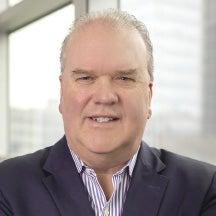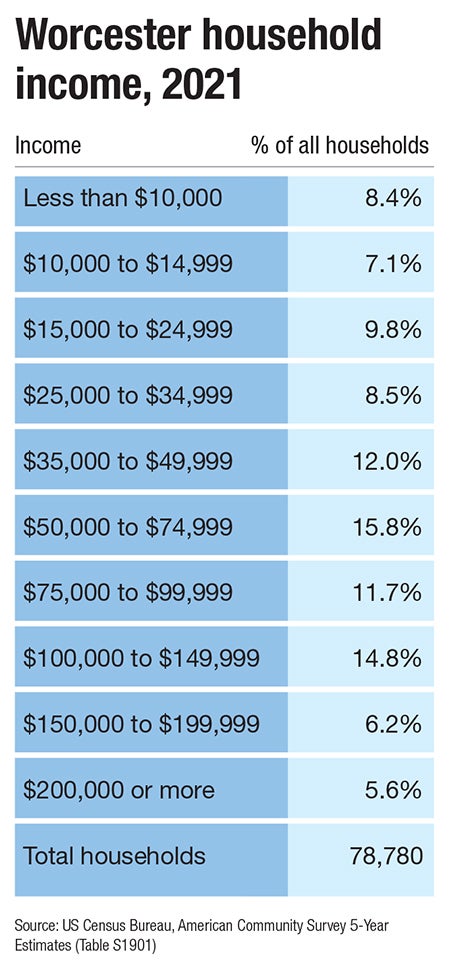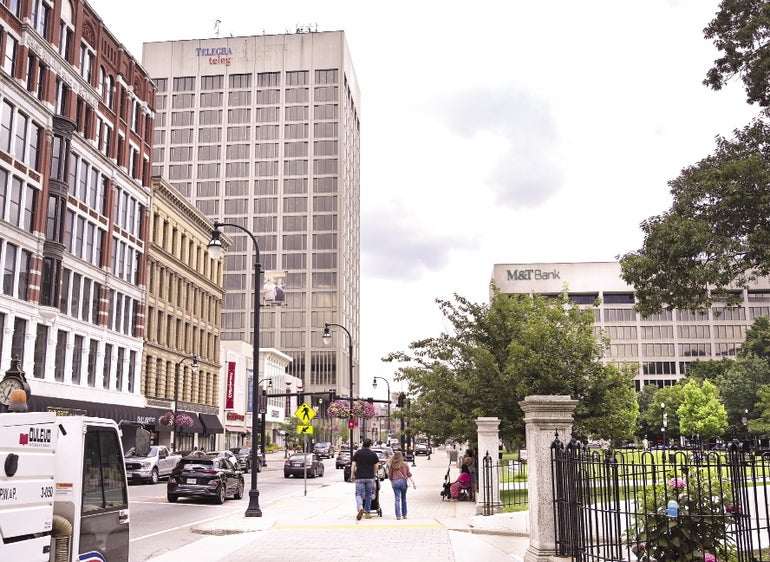Youth and magnetism seem like two great qualities to have in a city, but Worcester’s growing young population and stiff competition for real estate create problems city leaders must solve, in order for them to keep attracting people to the city.
Get Instant Access to This Article
Subscribe to Worcester Business Journal and get immediate access to all of our subscriber-only content and much more.
- Critical Central Massachusetts business news updated daily.
- Immediate access to all subscriber-only content on our website.
- Bi-weekly print or digital editions of our award-winning publication.
- Special bonus issues like the WBJ Book of Lists.
- Exclusive ticket prize draws for our in-person events.
Click here to purchase a paywall bypass link for this article.
Youth and magnetism seem like two great qualities to have in a city, but Worcester’s growing young population and stiff competition for real estate create problems city leaders must solve, in order for them to keep attracting people to the city.

The Worcester Regional Research Bureau tracks these and other city data points in its annual Worcester Almanac report, as well as other studies highlighting important demographic shifts in New England’s second-largest city.
Rising to the top in the 2023 Worcester Almanac are the increasing number of young people who call Worcester home, and the dearth of available housing. Its 2020 Census population of 206,518 is the highest it’s ever been, surpassing its previous peak in 1950, and 51% of Worcester residents are under 35 years old.
Meanwhile, the rental vacancy rate is around 3% – below the 5% to 10% rate considered healthy for the residential real estate market. As a result, Worcester is considered one of the hottest real estate markets in the Northeast, including ranking fourth on Realtor.com’s ranking for 2023.
That, city leaders say, isn’t as great as it sounds.

“Those aren’t places we want to be,” said David Sullivan, director of economic development and business recruitment for the Worcester Regional Chamber of Commerce.
Sullivan noted the city has seen its population rise 14% over 10 years.
“The question becomes how do we house all these people,” said Sullivan, adding Worcester needs more housing of all kinds.
Housing development factors going in wrong direction
The city is working to tackle the significant problem of lower-income households struggling to find a place to live.
But young professionals the city wishes to retain after they graduate from local colleges may be priced out of buying a home and are being pushed into the scramble for a vacant apartment.
Several high-visibility apartment developments have opened or are planned for downtown Worcester, including mixed-use projects that will provide retail shopping for residents.
But with hundreds of planned units in the pipeline, Sullivan said it’s really just a trickle of new stock.
With about 80,000 total housing units in the city, just 800 market-rate rental units have come online in the last four years.

“The rental units are at their ceiling for what they can bear, so people are forced to look for housing outside of Worcester,” Sullivan said.

John Tocco, managing partner and chief operations officer for V10 Development, said Worcester had a lot going for it when his company decided to build a multifamily apartment complex abutting Polar Park. Known as The Cove, it will add 173 high-end apartments to the bustling Canal District when complete.
“Worcester is a tremendous asset, and it’s tremendously underutilized,” said Tocco, a College of the Holy Cross alumnus who lives on the North Shore.
With amenities like Polar Park and numerous fine dining options within walking distance, plus proximity to outdoor destinations like Wachusett Mountain and the Berkshires, Worcester is a developer’s dream in many ways, he said.
But with a spate of similar projects in the pipeline from other developers, Tocco was dubious about future multifamily construction in Worcester.
Inclusionary zoning, which requires new projects to restrict up to 15% of units as affordable for renters who meet income guidelines, has put a damper on market-rate housing construction, Tocco said.
Meanwhile, the cost to develop such projects is climbing due to rising land values and interest rates impacting how much it costs to raise the debt to build, and construction materials themselves remain expensive, Tocco said.
“Everything is going in the wrong direction,” Tocco said, noting multiple factors would have to shift in order to consider building more rental housing in Worcester.
City Hall has launched 10 programs aimed at increasing affordable housing options for low- to moderate-income households since 2020, including programs funded by the federal American Rescue Plan Act.
New tools include a down-payment assistance program for first-time homebuyers, an inclusionary zoning policy requiring a certain number of new apartment units be set aside as affordable, and developing abandoned or foreclosed lots for new single- or two-family homes.

“A lot of people pay attention to the multifamily buildings, but we are focused on the neighborhoods for in-fill development,” said Peter Dunn, chief development officer for the City of Worcester.
Avoiding college graduate brain drain
With roughly 35,000 college students attending 10 colleges and universities in Worcester, the city has seen much progress in becoming a place new graduates might not want to leave.
Over the past decade, restaurants, cultural attractions and recreation options have blossomed, but affordable housing and jobs within city limits haven’t kept pace.
Expanding the employer base to create many local jobs across all levels of educational attainment must accompany the push for diverse housing options, Sullivan said.
“We need all of it and we need it now,” he said.
The Worcester Business Development Corp., the nonprofit charged with supporting economic development in the city, has set its sights on growing good jobs from larger employers.

WBDC President and CEO Craig Blais said the property known as The Reactory biomanufacturing complex is an example of a bid to attract large employers on the former Worcester State Hospital grounds. WuXi Biologics of China and Galaxy Life Sciences of Webster have plans for facilities to house several hundred jobs.
Now, WBDC wants to replicate those efforts as it works to clean up and ready a parcel in the Greendale neighborhood for reuse by a large industrial employer.
The site is adjacent to a power plant from French manufacturer Saint-Gobain.
“We want to find big employers, and we want to hold out,” said Blais.
Worcester’s growing affluence
Such efforts will create avenues for people in lower income brackets in a city that appears to be growing more affluent.

Household income in Worcester is on the rise, which may signal a rebound to levels seen in 2010. In 2021, 26.6% of Worcester households earned at least $100,000, compared with 24.1% the previous year.
The biggest gains were in the $150,000 and higher bracket, which accounted for 11.8% of households, an increase of almost 2 percentage points from 2020.
Meanwhile, those households earning under $50,000 decreased from 49% to 45.8%.
Worcester, and Central Massachusetts more broadly, are new options for those who have been priced out of the Greater Boston real estate market, which may contribute to growing household income, said Dunn. People who are working remotely or on hybrid schedules can easily afford a home in the city, leading to an anecdotal westward migration.
“The good news: [Worcester is] a desirable place to live,” Dunn said.

Worcester native Paul Matthews, who became executive director of the Worcester Regional Research Bureau in 2019, agreed people are thinking more expansively about where to live.
The fact that there’s new downtown housing in walking distance to the Union Station transportation hub – a long-time vision of city leaders – plus attractions like the Worcester Red Sox, Worcester Railers Hockey Club, and The Hanover Theatre, explain why Matthews sees a lot more people younger than 40 with dogs walking around the city, he said.
“Life’s ever changing and so is the city,” Matthews said.

